PART TWO
Trains to the Midwest, the Desert Southwest and the Pacific Northwest
Any of you who’ve read my past trip reports know that there’s simply no way that I could only go to New Orleans for dinner. I need to make a real trip out of this! For me that means some First Class train travel, a bit of mileage running and a good road trip. Why not see the country instead of just fly over it? My Amtrak Guest Reward Account was approaching 46000 points, so I decided to use 20000 of those points for a five day – four night rail extravaganza from New Orleans to Chicago before continuing on to Los Angeles and on up to Seattle. From there I’ll fly down to San Diego and commence a six day, 1600 mile drive around the Desert Southwest. Many of the roads I’ll be driving along I’ve driven before, so this time there’ll be an added twist: I’ve booked a seat in the First Class Parlor Car on the Grand Canyon Railway from Williams, Arizona up to the south rim of the Grand Canyon. Afterwards I’ll continue on to Flagstaff, up to Green River, Utah and then across to Death Valley National Park before making my way back down through the Mojave Desert and over the San Gabriel Mountains to San Diego.
United, Delta and Alaska all offer good fares from San Diego to the Northeast, so I’ve booked a quick roundtrip to Boston on United before switching over to Delta for a two stop journey back over to Portland, Maine. The next morning Amtrak’s
Downeaster will whisk me down to Boston, arriving in plenty of time to watch my favorite baseball team play at my favorite ball park. That would be the Oakland A’s playing at Boston’s Fenway Park. I’ve got Grandstand seats about 20 rows up from first base and I’m looking forward to seeing my A’s play in person for the first time since 1997. Later that evening Alaska Airlines will provide First Class comfort on the six hour nonstop to San Diego. The next day it’s on to Denver (via Seattle, of course) for a couple days of meetings with family, dentist and bankers before flying back up to Fairbanks, just in time to drive down to Denali and resume my job driving America’s most tenacious travelers deep into the wilds of Denali National Park.
We’ve got an hour and a half until the train leaves, so let’s head on into the station and check out the Magnolia Room.
Day Four
Amtrak New Orleans to Chicago 145p – 900a City of New Orleans First Class
The Illinois Central Railroad introduced the original
City of New Orleans in 1947 as a daytime companion to the overnight
Panama Limited. Because the majority of the schedule was run during daytime hours, the original
City of New Orleans did not have the sleepers, fine dining and stylish parlor cars of the much more luxurious
Panama Limited. It sure was fast, though! Early timetables show the
City of New Orleans covering the 921-mile route between New Orleans and Chicago in just 15 hours and 25 minutes. The relatively flat route along the Mississippi River combined with tracks that were in much better condition back then allowed the train to average over 60mph, occasionally reaching speeds of up to 100 mph. At that time this was the longest daytime schedule in the United States.
 Route of The City of New Orleans
Route of The City of New Orleans
My first ride on the
City of New Orleans came back in 1983. Amtrak had taken over operation of virtually all of the nation’s passenger rail operations in 1971 and unfortunately it had done little to upgrade the
City of New Orleans. The consist was made up of older Heritage Fleet equipment and while there was a lounge car, no true dining car was included. Coach passengers as well as First Class passengers from the sleeper got their meals reheated in the Amfleet II café. An article in Trains magazine referred to the
City of New Orleans as "Amtrak's Least Glamorous Long-Distance Train".
It’s worth noting that when Amtrak took over the Chicago to New Orleans route back in ‘71, it retained the
Panama Limited name for its scheduled overnight train. However, after Arlo Guthrie memorialized the old daytime
City of New Orleans with his famous folk ballad (The song was actually written by Steve Goodman), so much attention was called upon the train that Amtrak decided to switch the name of its train to the
City of New Orleans! Ironically, based upon the times mentioned in the lyrics (
Nighttime on The City of New Orleans, Changing cars in Memphis, Tennessee) and the sad state of the service back then, Goodman may well have written his song based upon an experience aboard the
Panama Limited in its final days before Amtrak. Let’s check out the lyrics:
The City of New Orleans
by Steve Goodman
Riding on the City of New Orleans,
Illinois Central Monday morning rail
Fifteen cars and fifteen restless riders,
Three conductors and twenty-five sacks of mail.
All along the southbound odyssey
The train pulls out at Kankakee
Rolls along past houses, farms and fields.
Passin' trains that have no names,
Freight yards full of old black men
And the graveyards of the rusted automobiles.
CHORUS:
Good morning America how are you?
Don't you know me I'm your native son,
I'm the train they call The City of New Orleans,
I'll be gone five hundred miles when the day is done.
Dealin' card games with the old men in the club car.
Penny a point ain't no one keepin' score.
Pass the paper bag that holds the bottle
Feel the wheels rumblin' 'neath the floor.
And the sons of Pullman porters
And the sons of engineers
Ride their father's magic carpets made of steel.
Mothers with their babes asleep,
Are rockin' to the gentle beat
And the rhythm of the rails is all they feel.
CHORUS
Nighttime on the City of New Orleans,
Changing cars in Memphis, Tennessee.
Half way home, we'll be there by morning
Through the Mississippi darkness
Rolling down to the sea.
And all the towns and people seem
To fade into a bad dream
And the steel rails still ain't heard the news.
The conductor sings his song again,
The passengers will please refrain
This train's got the disappearing railroad blues.
Good night, America, how are you?
Don't you know me I'm your native son,
I'm the train they call The City of New Orleans,
I'll be gone five hundred miles when the day is done.
©1970, 1971 EMI U Catalogue, Inc and Turnpike Tom Music (ASCAP)
Since its rocky inception in May of 1971, things have improved a bit for Amtrak and – by extension – the
City of New Orleans. Bi-level Superliner II cars and new diners were added in the 1990s, providing the
City of New Orleans with real dining service. While the menu was less varied than that of other Superliner trains, the new dining service represented a significant improvement over the microwaved tray meals that were previously offered. When I last rode this train in 1997 its dining car featured a customized menu with dishes that reflected New Orleans' cuisine. It was a welcome upgrade to a train that’s long deserved better!
Moving on to the present, here I was in New Orleans’ Union Passenger Terminal with an hour and a half to go before train time. Back in the eighties this facility sported a very nice cafeteria where $4.00 would get you a memorable plate of red beans and rice with Andouille sausage. Today, the cafeteria has been replaced by a Subway sandwich shop. The game room is still there but unfortunately my old favorite - a Ms. Pacman game - sat dark and silent, out of order.
But wait! I’m rolling out of here in First Class, today. That means I get to go lounge in the Magnolia Room, a private waiting area reserved for Sleeping Car passengers only. The entrance is through twin glass doors guarded by a lock which requires a passcode (easily obtained from the ticket counter) as there are no staff assigned to the room to assist passengers in any way. Inside are a couple dozen chairs, a TV, a small coffee urn and a water dispenser. There are no snacks provided, no computers, no Wi-Fi and no restrooms. In short, the only real benefit to this “lounge” would be that it’s quieter and the cushioned chairs are more comfortable than sitting on the hard plastic seats out in the main lobby.
In retrospect, I’d recommend spending more time in New Orleans and then plan to arrive at the station about 1:30 so you can just board immediately. And while you’re at it, why not grab a “Hurricane” to go before heading over to the terminal!
It was about 1:30 when an Amtrak employee entered the lounge and announced that the train was ready to board. We were escorted to the main station doors and directed down the platform to the waiting train. Today’s consist included a single P42DC locomotive, two sleepers, a Cross Country Café diner/lounge, a Sightseer Lounge Car and three coaches. Once again I had to walk the length of the train as this time the sleepers – not the coaches – were at the front of the train!
Waiting at the entrance to my sleeper with a passenger manifest was my car attendant, Lisa. After verifying my name was on her list, she directed me to enter and turn left where I’d find my roomette on the lower level, just past the luggage racks. I stowed my suitcase there and headed down the hall to my room.
 Boarding The City of New Orleans
Boarding The City of New Orleans
Each Amtrak bi-level
Superliner Sleeper car offers 14
Roomettes, 5 Deluxe bedrooms, 1 Family bedroom and one Handicapped bedroom. Four roomettes along with the Family and Handicapped bedrooms are located downstairs. The roomettes measure 3’6” by 6’6” and are accessed via a sliding glass door. During the day they offer two wide opposite facing seats that fold together to become a bed at night. Above them is a fold-down upper berth. Other amenities include four separate lights, an electrical outlet, a tall mirror, a fold out table, a small open closet with hangers and a thermostat which I immediately turned to its lowest level. Best of all, each compartment has its own huge window, approximately 2’ X 5’, through which to view the passing scenery. Toilet and shower facilities are down the hall. For a single traveler, I think these roomettes are quite sufficient and comfortable which is a good thing because they would be my home for the next four nights.
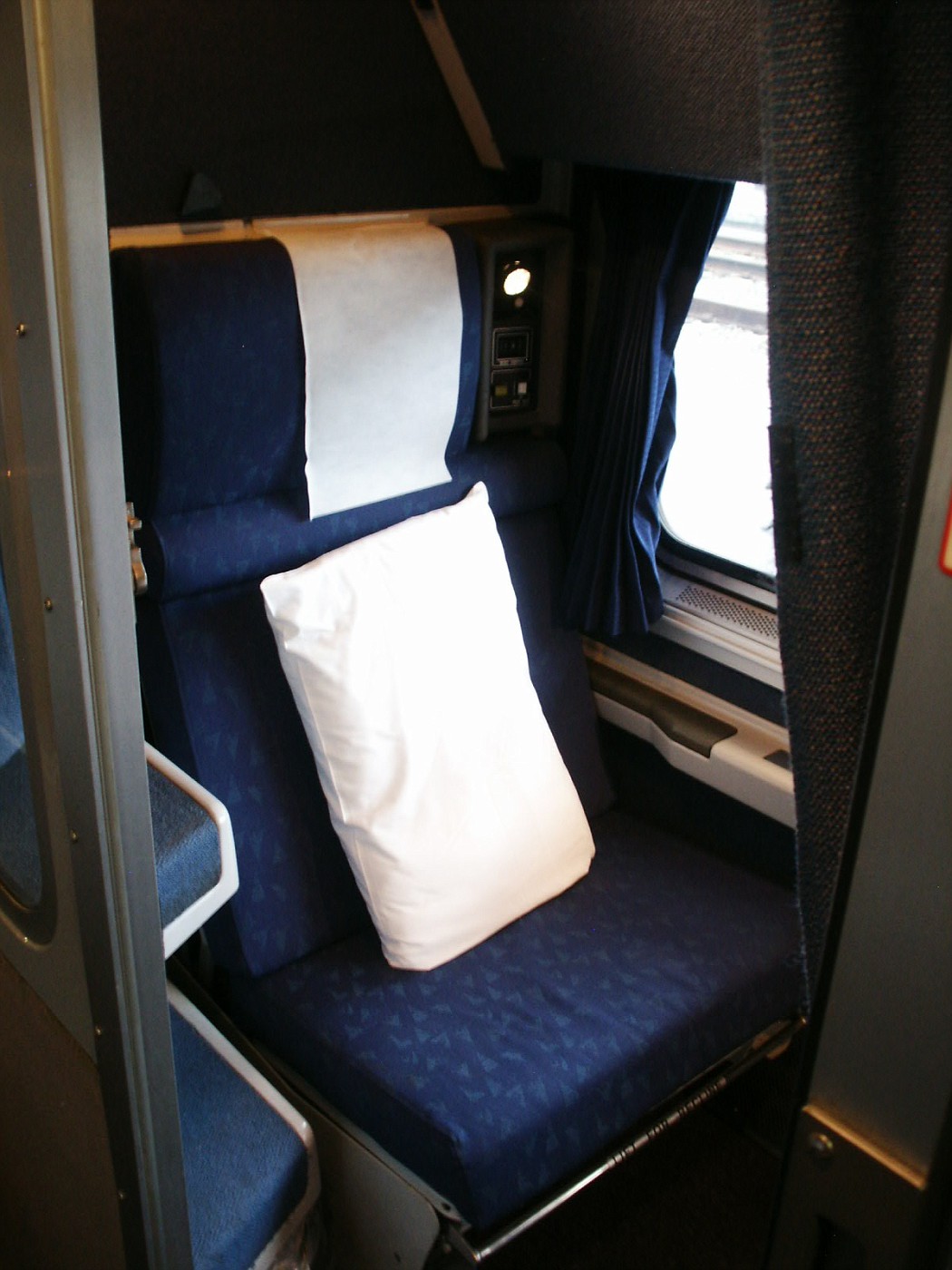 Amtrak Superliner Roomette
Amtrak Superliner Roomette
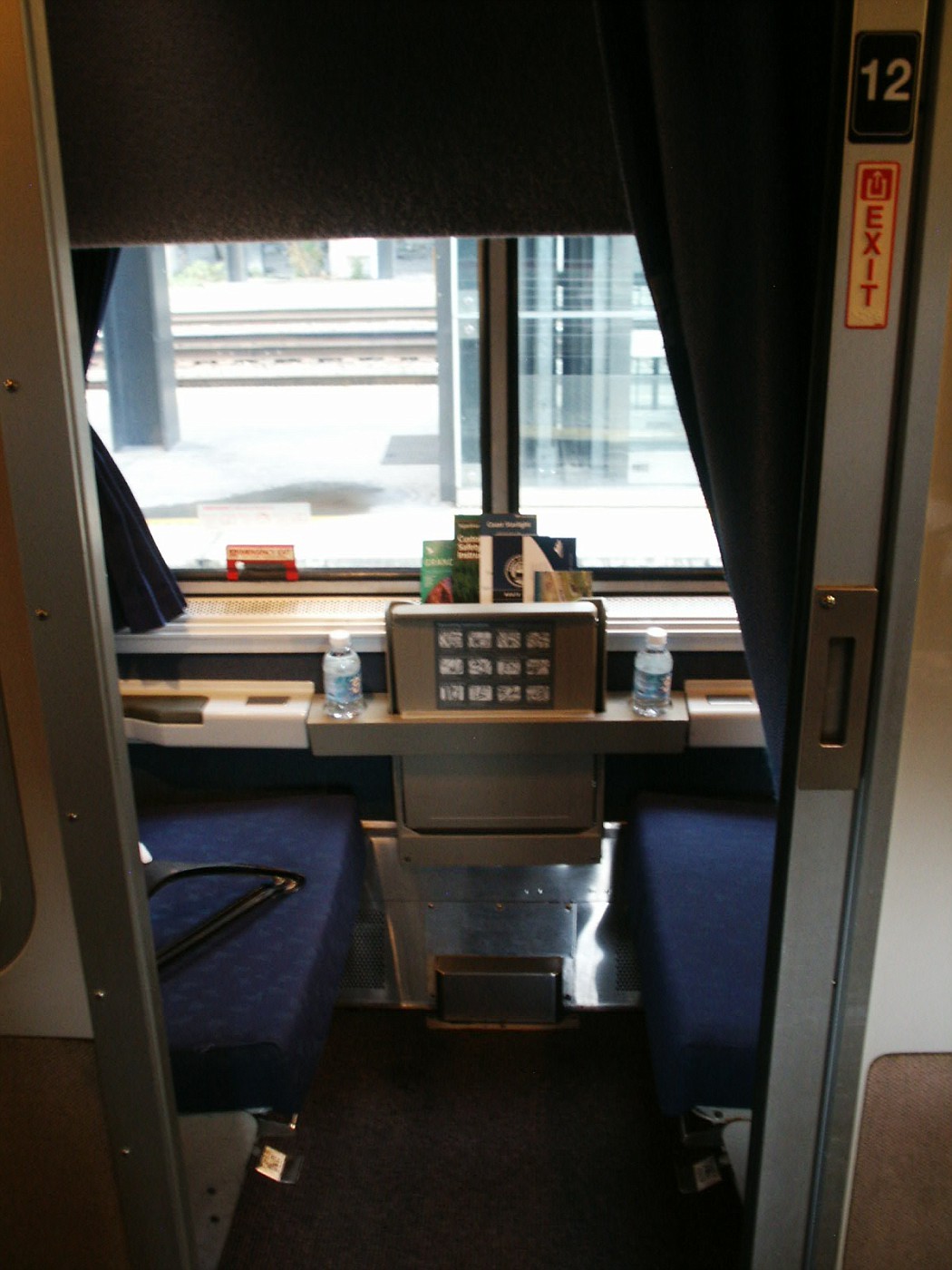 Amtrak Superliner Roomette
Amtrak Superliner Roomette
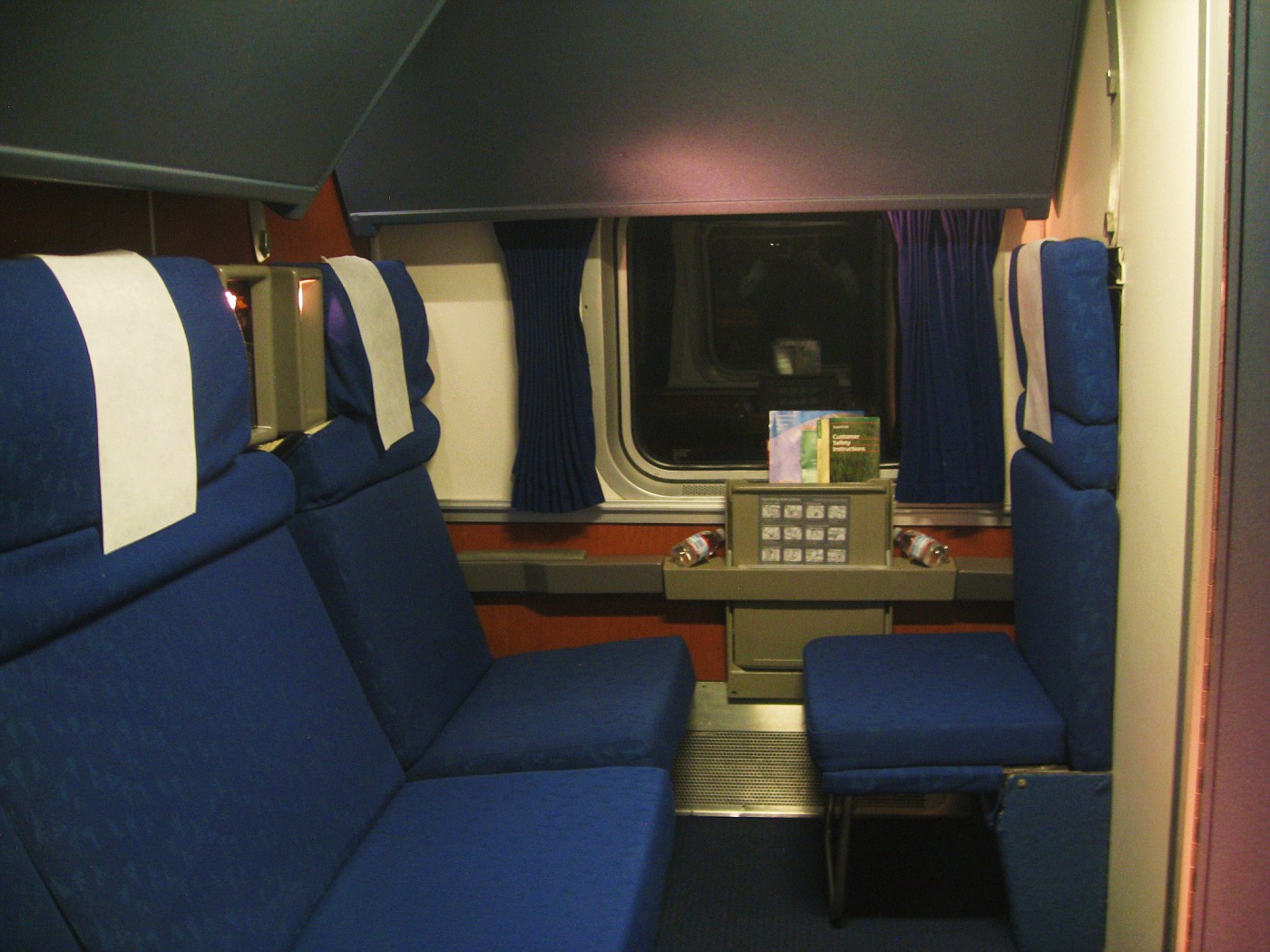 Amtrak Superliner Lower Level Bedroom
Amtrak Superliner Lower Level Bedroom
At my seat were two big fluffy pillows and a small grey amenities bag containing shampoo, conditioner and lotion. On the center console where the table is stored were two bottles of water and a variety of pamphlets about the train. There was a route guide, a timetable, a safety card much like you’d see aboard an airliner and a brochure describing the train and its various services and attractions.
Although most people are excited about the prospect of a seat or bedroom high on the upper level of Amtrak’s Superliner fleet, I specifically chose a lower level room for two reasons. First, the downstairs rooms are quieter because there is much less foot traffic passing by your door. All the inter-car traffic is upstairs. As well, the train’s natural rocking motion makes for a difficult time walking and most people tend to ricochet their way down the narrow hallways, bouncing off walls and doors with equal abandon. One sleeping car passenger complained that her arms were bruised after just one afternoon on the train. Secondly, riding in the lower level of the car results in much less tilt motion than is experienced on the upper levels. Like a fulcrum point on a seesaw, the ride is smoother the lower you are.
At the top of the stairway is the service area for each car. In the morning, juice and coffee are available from this area. Ice is available throughout the day.
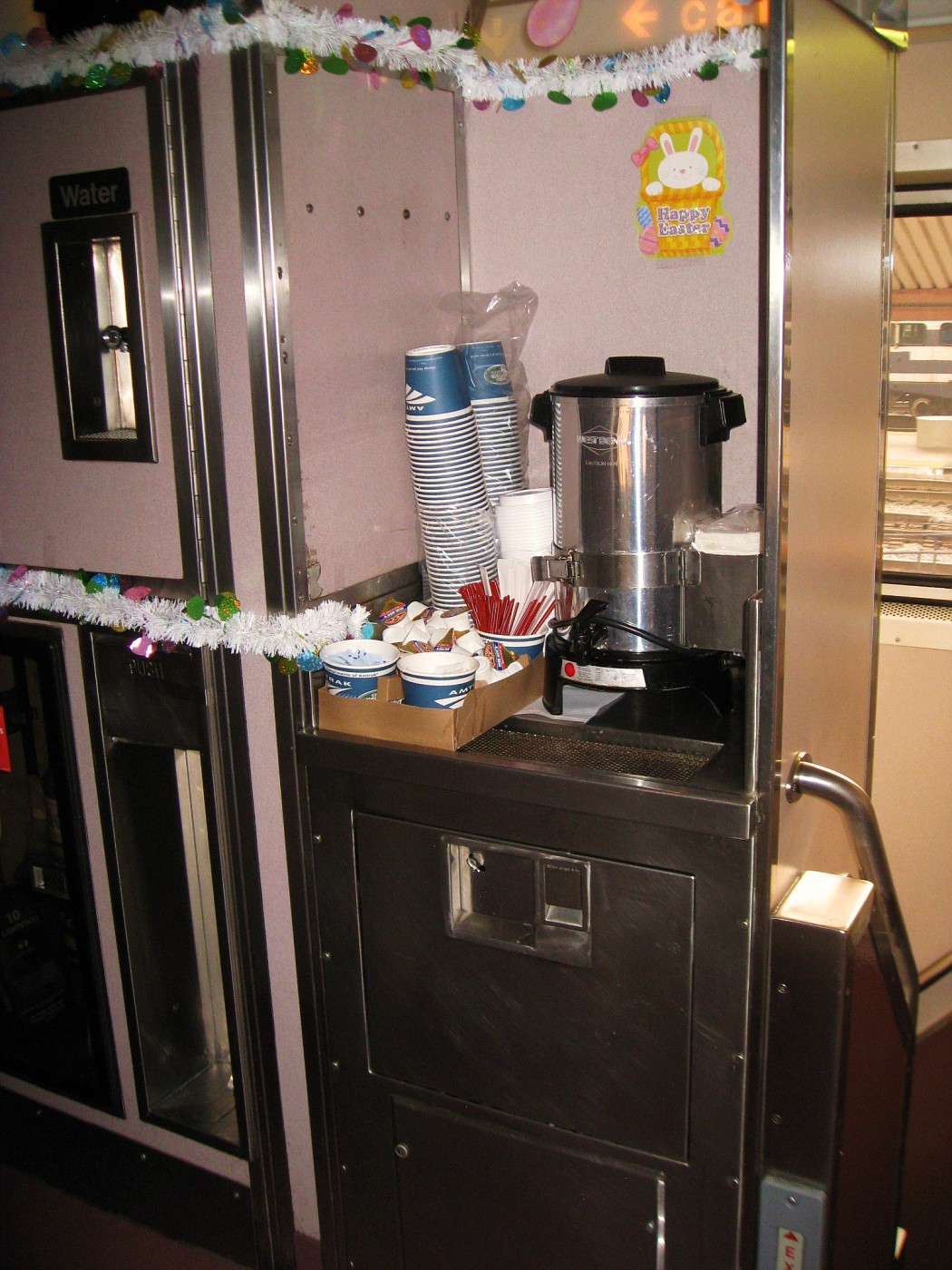 Amtrak Service Area
Amtrak Service Area
Taking quick stock of my surroundings and satisfied that all was in order, I hung my jacket and then grabbed my camera and stepped off the train for a couple of photos. Train travel is exciting stuff with plenty of sights, sounds and smells to stimulate the senses. Boarding most airplanes these days has become a relatively sterile experience as you’re usually separated from your aircraft by large glass windows and a jet bridge. By comparison, you must walk up to and meet your train. It’s right there in front of you – big, silver and inviting your inspection. Amtrak’s bi-level Superliner cars are huge, towering above those of us down on the platform. Even at idle the big diesel locomotives are quite loud, emitting a variety of noises such as changes in rpms or frequent short releases of air. I was joined by a couple of other passengers who were also photographing the scene. I chatted briefly with a guy named Jack who claimed this was his sixth ride on the
City of New Orleans. It was nice to see the excitement and passion for a train ride still burned bright within him.
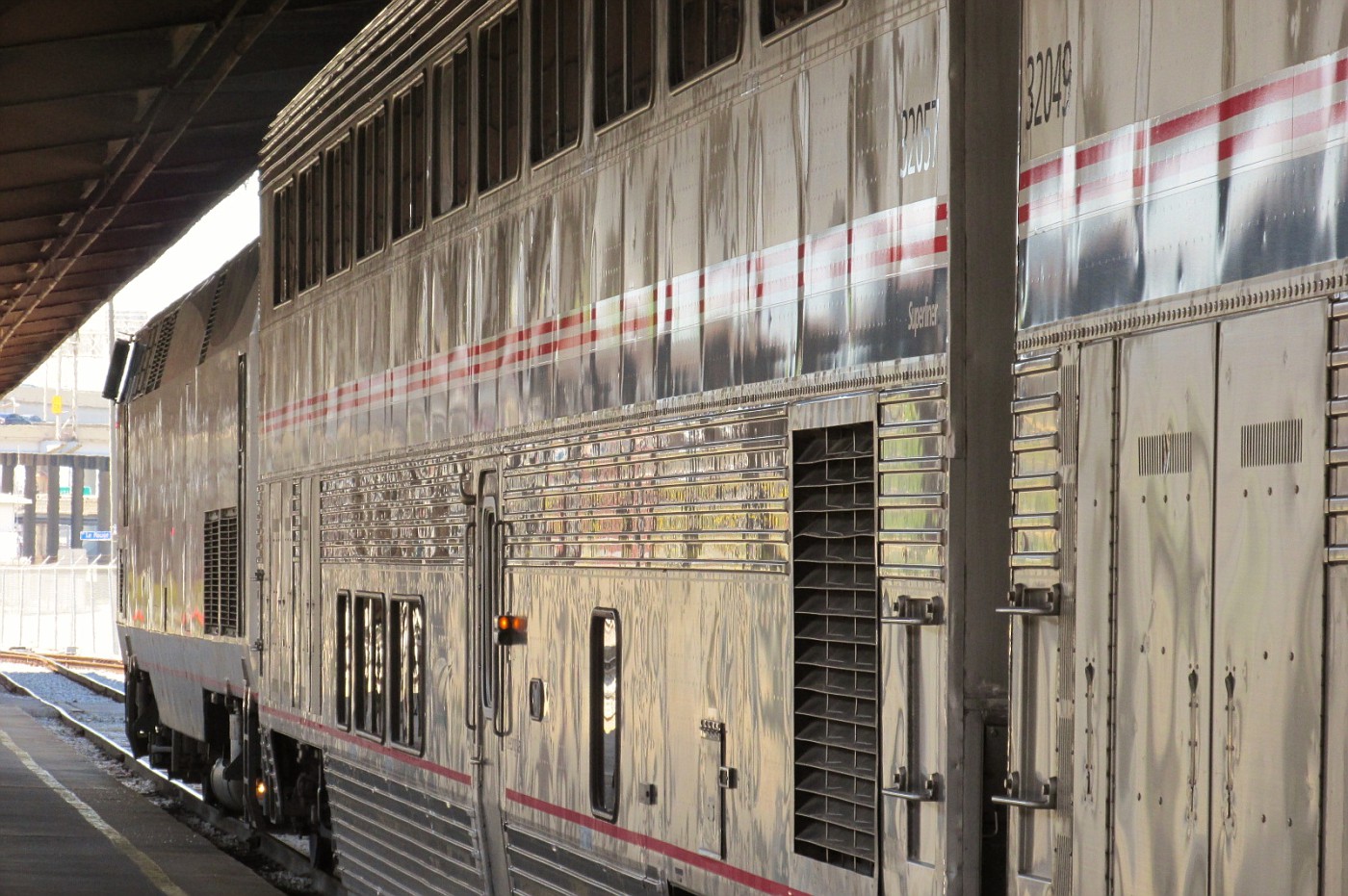 A Wall of Train
A Wall of Train
It wasn’t long before the “All Aboard!” call rang out and we quickly re-boarded the train. The doors were closed, the step stools stowed and just like that, the
City of New Orleans slowly accelerated out of the station. Chicago was 19 hours and 934 miles to the north. Settling into my wide seat, I reclined it a bit and watched as we rolled through the suburbs of New Orleans and out onto the causeway that crosses Lake Ponchartrain. Looking out my window at the vast expanse of water, we could just as easily have been on a ship.
An announcement was made that the dining car steward would soon be passing through the cars taking reservations for tonight’s dinner seatings. He’d be starting with the sleepers and moving backward to the coaches. A variety of times between 5:30 and 7:30pm were available. I stuck around until he arrived and then chose the 6:15 seating for my dinner.
One downside to this particular train was that the windows were not very clean. Sure, you could see through them well enough but good clear photographs would not be forthcoming. Many end of the line stations like New Orleans have car washers – either human or mechanical – but evidently that hadn’t happened for today’s train. That’s all right, I guess. After all, scenery is only half the fun of a long distance train trip.
It’s been said that a train is a place that’s going somewhere. How true! To begin with, I’m traveling aboard a train named the “
City of New Orleans”. This sounds much more personable than a seat aboard a nameless 737-800 or a regional jet. Indeed, when it comes to train names, the railroads have it all over the airlines. I mean, consider the prospect of a trip aboard the “
Twentieth Century Limited”, the “
Silver Star” or the “
Coast Starlight” as opposed to a flight on an “Airbus”, a “Jumbojet” or a “757 Luxuryliner” upon which a debatable semblance of luxury is extended to only a small fraction of its total passengers
Unlike an airplane flight where most passengers spend the entire flight confined to their seat - many of them with their window shades down - passengers on a long distance train have the option of strolling up to the Lounge Car to meet, drink and trade stories with their fellow travelers. Those who desire a bite to eat can wander up to the Dining Car or, for lighter fare, head to the Snack Bar located on the lower level of the lounge car. Conversely, those who desire a bit of peace and quiet can easily find it within the confines of their compartment or even at a seat in the lounge car where many are content to settle in and watch the scenery roll by through the large picture windows which start at knee level and extend all the way up to the ceiling. Some people bring books and magazines; others are wired into their mp3 players. Everyone is enjoying the journey in their own way.
As we sped north through the Bayou and Piney Woods towards communities like Hammond, Brookhaven and Jackson, Mississippi I noticed that the engineers sure seemed enthusiastic in their use of the train’s horn. It seemed to blow constantly as we sped through numerous small hamlets and past innumerable road crossings. I once read that a higher percentage of cars are hit by trains in Southern states than anywhere else in the nation, so perhaps this has something to do with the horn usage. Or maybe the engineers are just excited to be driving their train along at 79mph on a nice sunny afternoon. Woo-Hoo! We be cruisin' now!! Yeah!!! Either way, this train really rips along and life does not always turn out like an episode of The Dukes of Hazzard. Drivers of smaller cars and pick-up trucks would be wise to give this train a wide berth!
One interesting aspect of our journey through Mississippi was all the pretty little towns we passed through. The old brick buildings and wooden houses looked very attractive in the late afternoon sun. Some of these towns looked to be on the verge of becoming ghost towns with deserted buildings, derelict cars and machinery littering the surrounding lands. Some towns were more trailer parks than houses. As pretty as the landscape was, clearly life was tough on many of this region’s inhabitants.
The afternoon passed quickly and by the time we pulled into Jackson the sun sat low on the horizon under a clear azure sky. As we continued north of Jackson, I could just imagine being out here on some hot summer evening, sitting on the front porch of an old wooden house with my blue tick hound and a cold beer - watching the trains go by while June bugs rhapsodized us from the surrounding Magnolia trees.